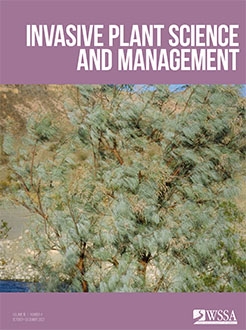One way that climate change is projected to affect invasive plant management is by shifting the ranges of invasive plants. In some regions, hundreds of new, potentially invasive species could establish in coming decades. These species are prime candidates for early detection and rapid response. However, with limited resources, it is unlikely that invasive plant managers will be able to monitor and treat this large number of novel species. Determining which species are likely to have the greatest impacts could inform further risk assessment and mitigate the greatest amount of potential damage. Here, we used the Environmental Impact Classification for Alien Taxa (EICAT) protocol to evaluate the potential impacts of 104 invasive plant species that are projected to establish in Delaware, Kentucky, Maryland, New Jersey, Ohio, Pennsylvania, Virginia, and/or West Virginia by midcentury with climate change. These species were identified using the Invasive Range Expanders Listing Tool to predict which invasive species are likely to shift their ranges into the target states by midcentury. We used Web of Science to search for studies on each species involving impacts to ecological or socioeconomic sectors. We scored ecological impacts on a scale of 1 (“minimal concern”) to 4 (“major concern”) and socioeconomic impacts as present or not present. We evaluated 674 papers and categorized the species into these categories: 32 high-impact species, 20 moderate-impact species, and 13 minor- or minimal-impact species. Two of the 32 high-impact species (panic veldtgrass [Ehrharta erecta Lam.] and Athel tamarisk [Tamarix aphylla (L.) Karst.]) pose a risk to all eight mid-Atlantic states. There were also 46 species that pose a risk to socioeconomic sectors, including agriculture, the economy, and human health. Twenty-four species were listed as data deficient (no data could be found on them). This study provides a comprehensive review of reported impacts of range-shifting invasive plants in the mid-Atlantic.
BioOne.org will be down briefly for maintenance on 17 December 2024 between 18:00-22:00 Pacific Time US. We apologize for any inconvenience.
How to translate text using browser tools
6 October 2023
High-impact invasive plants expanding into mid-Atlantic states: identifying priority range-shifting species for monitoring in light of climate change
Justin D. Salva,
Bethany A. Bradley
ACCESS THE FULL ARTICLE
ecological impacts
EICAT
prioritization
weed risk assessment






